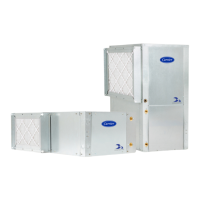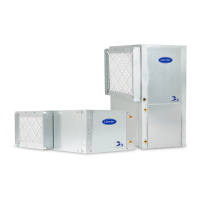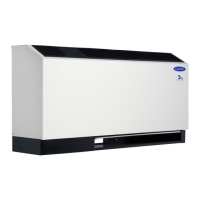24
UPM Dip Switch Settings
The DIP switches are used to configure most of the available fea-
tures of the UPM as follows:
• Lockout mode: two (2) or four (4) strikes
• Reset mode: Y signal or R signal
• Alarm mode: Constant or Pulse
• Test mode: Normal or Test operation
Figure 21 shows the factory default settings for most heat pump
applications. However, the unit wiring diagram is the ultimate
guide for factory DIP switch default settings. See the Unit Pro-
tection Module section in the Troubleshooting section for further
details.
Fig. 21 — Typical DIP Switch Factory Defaults
Table 7 — UPM DIP Switch Options
Table 7 above shows the available options on the UPM board DIP
switch banks.
Alarm Output
Alarm output is normally open (NO) dry contact. If pulse is select-
ed the alarm output will be pulsed. The fault output will depend on
the DIP switch setting for ALARM. If it is set to CONST, a con-
stant signal will be produced to indicate a fault has occurred and
the unit requires inspection to determine the type of fault. If it is
set to PULSE, a pulse signal is produced and a fault code is detect-
ed by a remote device indicating the fault. The remote device must
have a malfunction detection capability when the UPM board is
set to PULSE.
WATERSIDE ECONOMIZER
Units with waterside economizer and Complete C or Deluxe D
controls include an aquastat for economizer control. The aquastat
can be adjusted between 20°F and 60°F. When the water loop tem-
perature is below the aquastat set point, the economizer is enabled.
The recommended aquastat set point is 55°F. See Fig. 22.
BOILERLESS HEAT CONTROL (DELUXE D ONLY)
All units with Deluxe D control include an aquastat for boilerless
heat control. The aquastat can be adjusted between 20°F and 60°F.
When the water loop temperature is below the aquastat set point,
the heat pump heating is disabled and a field provided auxiliary
heat can be enabled. The recommended aquastat set point is 55°F.
See Fig. 22.
Fig. 22 — Aquastat for Waterside Economizer and
Boilerless Control
PRE-START-UP
System Checkout
After completing the installation, and before energizing the unit,
the following system checks should be made prior to initial start-
up:
1. Verify that the supply voltage to the heat pump is in accor-
dance with the nameplate ratings.
2. Verify that the control transformer is set to the correct voltage
for 208/230V units (factory setting is 230V).
3. Make sure that all electrical connections are tight and secure.
4. Check the electrical fusing/breaker and wiring for the correct
size.
5. Verify that the low voltage wiring between the thermostat or
DDC controls and the unit is correct.
6. Verify that the water piping is complete and correct.
7. Verify that there are no leaks in the external piping or in the
internal unit piping. Correct as necessary.
8. Verify that the isolation or flow control valves are open and
that any automatic flow control valve or balancing valve are
set to the correct setting.
9. Check that the water flow is correct and adjust if necessary.
10. Check the blower for free rotation, and that it is secured to the
shaft.
11. Verify that the foam blower shipping support has been
removed.
12. Vertical Units Only - Verify that vibration isolation has been
provided and that the unit has been installed on a solid struc-
ture.
13. Horizontal Units Only - Verify that the hanging brackets have
been installed and that the unit is secured to an adequate sup-
port structure.
SWITCH
NUMBER
DIP SWITCH ON OFF
4LOCKOUT4 2
3 RESET R Y
2 ALARM CONT PULSE
1 TEST YES NO
CAUTION
Operation of unit in test mode can lead to accelerated wear and
premature failure of components. The "TEST" switch must be
set back to "NO" after troubleshooting/servicing.
IMPORTANT: If 24 VAC output is needed R must be wired
to ALR-COM terminal; 24 VAC will be available to the
ALR-OUT terminal when the unit is in the alarm condition.

